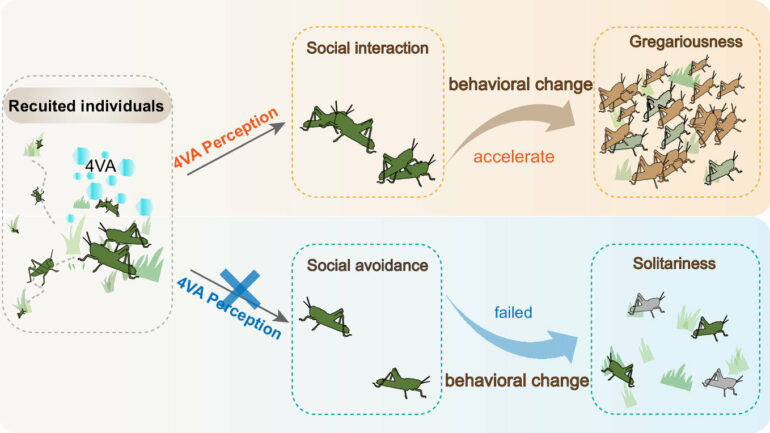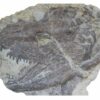In a study published in the Proceedings of the National Academy of Sciences on Sept. 5, researchers led by Prof. Kang Le from the Beijing Institutes of Life Science of the Chinese Academy of Sciences have provided a deep understanding of the “sociability” of individual locusts and explained how a pheromone influences locust group formation.
Locusts are one of the most destructive pests in agriculture because they can form large swarms that cause immense damage to crops. The transition from solitary, low-density locusts to gregarious, high-density locusts is the biological basis for swarm formation and the outbreak of locust plagues. However, the mechanisms whereby solitary locusts undergo a phase change and exhibit aggregation and collective behavior have not been well understood.
In 2020, Dr. Kang’s team identified the locust aggregation pheromone 4-vinylanisole (4VA) using multiple approaches. 4VA is exclusively released by gregarious locusts but is able to attract and recruit solitary locusts. Can 4VA affect the behavioral transition of solitary locusts to gregarious locusts that can then form large swarms and undertake long-term migrations?
In this study, Kang’s team investigated the role of 4VA in locust behavioral plasticity by examining the behavioral changes of solitary locusts in the presence and absence of 4VA. They found that solitary locusts typically required 48–72 hours of crowding to exhibit gregarious behavior. However, exposure to 4VA significantly reduced this transition time to only 24 hours.
When RNA interference (RNAi) was applied to the olfactory receptor OR35, which is responsible for detecting 4VA, solitary locusts were unable to initiate the behavioral phase change, and gregarious locusts were unable to maintain their gregarious behavior—instead exhibiting behavior similar to solitary locusts.
To further investigate the mechanisms behind 4VA’s regulation of locust behavioral transformation, the researchers developed a multi-individual behavioral assay system to assess social interactions among locust individuals. They revealed a positive correlation between four parameters representing social interaction and behavior during the crowding process.
Inclusion of 4VA significantly increased the propensity for proximity and bodily contact among conspecifics, particularly crucial touches such as mounting and straddling, thus facilitating the rapid transition from “solitary” to “gregarious” locusts. These results illustrate that 4VA influences the behavioral phase transition of locusts by modulating social interactions among locusts.
This study elucidates the role of 4VA as a chemical sensory factor governing the transition from solitary to gregarious behavior in locusts. It provides insights into locust behavioral plasticity, population density, and the progressive nature of locust aggregation, thereby revealing the captivating “social code” behind insect aggregation.
These results, by improving our understanding of why locusts aggregate and subsequently cause plagues, are important for the development of environmentally friendly locust control measures and the precise timing of locust control efforts.
More information:
Jing Yang et al, 4-Vinylanisole promotes conspecific interaction and acquisition of gregarious behavior in the migratory locust, Proceedings of the National Academy of Sciences (2023). DOI: 10.1073/pnas.2306659120
Provided by
Chinese Academy of Sciences
Citation:
‘Sociability’ of locusts: Social interactions promote aggregation (2023, September 12)



